建筑英语演讲稿
关于建筑的主讲英文稿范文
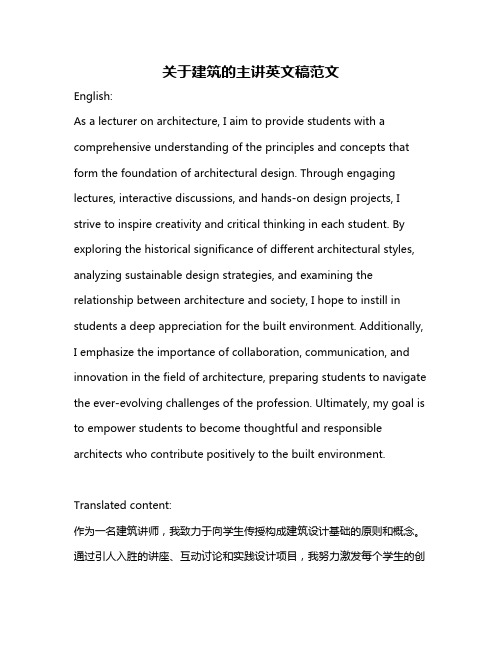
关于建筑的主讲英文稿范文English:As a lecturer on architecture, I aim to provide students with a comprehensive understanding of the principles and concepts that form the foundation of architectural design. Through engaging lectures, interactive discussions, and hands-on design projects, I strive to inspire creativity and critical thinking in each student. By exploring the historical significance of different architectural styles, analyzing sustainable design strategies, and examining the relationship between architecture and society, I hope to instill in students a deep appreciation for the built environment. Additionally, I emphasize the importance of collaboration, communication, and innovation in the field of architecture, preparing students to navigate the ever-evolving challenges of the profession. Ultimately, my goal is to empower students to become thoughtful and responsible architects who contribute positively to the built environment.Translated content:作为一名建筑讲师,我致力于向学生传授构成建筑设计基础的原则和概念。
介绍建筑的高中英语作文

介绍建筑的高中英语作文Introduction to Architecture。
Architecture is the art and science of designing and constructing buildings. It encompasses a wide range of activities, from the initial planning and design of a structure to its final construction and maintenance. The field of architecture is constantly evolving, with new technologies and materials being developed all the time. This makes it an exciting and challenging profession to pursue.History of Architecture。
The history of architecture can be traced back to ancient civilizations, such as the Egyptians, Greeks, and Romans. These cultures developed their own unique styles of architecture, which were characterized by their use of specific materials, such as stone, wood, or brick, andtheir use of decorative elements, such as columns, arches,and friezes.During the Middle Ages, architecture was largely influenced by the Catholic Church, which commissioned the construction of many grand cathedrals and churches. Gothic architecture, with its pointed arches and elaborate ornamentation, was particularly popular during this time.In the Renaissance period, architecture became more focused on the principles of proportion and symmetry. The work of Italian architect Andrea Palladio, for example, was characterized by its use of classical elements, such as columns and pediments, and its emphasis on balance and harmony.Modern Architecture。
英语介绍建筑演讲稿
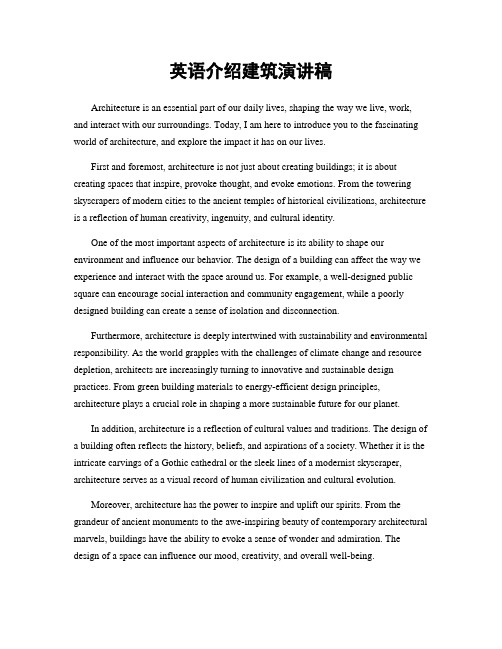
英语介绍建筑演讲稿Architecture is an essential part of our daily lives, shaping the way we live, work, and interact with our surroundings. Today, I am here to introduce you to the fascinating world of architecture, and explore the impact it has on our lives.First and foremost, architecture is not just about creating buildings; it is about creating spaces that inspire, provoke thought, and evoke emotions. From the towering skyscrapers of modern cities to the ancient temples of historical civilizations, architecture is a reflection of human creativity, ingenuity, and cultural identity.One of the most important aspects of architecture is its ability to shape our environment and influence our behavior. The design of a building can affect the way we experience and interact with the space around us. For example, a well-designed public square can encourage social interaction and community engagement, while a poorly designed building can create a sense of isolation and disconnection.Furthermore, architecture is deeply intertwined with sustainability and environmental responsibility. As the world grapples with the challenges of climate change and resource depletion, architects are increasingly turning to innovative and sustainable design practices. From green building materials to energy-efficient design principles, architecture plays a crucial role in shaping a more sustainable future for our planet.In addition, architecture is a reflection of cultural values and traditions. The design of a building often reflects the history, beliefs, and aspirations of a society. Whether it is the intricate carvings of a Gothic cathedral or the sleek lines of a modernist skyscraper, architecture serves as a visual record of human civilization and cultural evolution.Moreover, architecture has the power to inspire and uplift our spirits. From the grandeur of ancient monuments to the awe-inspiring beauty of contemporary architectural marvels, buildings have the ability to evoke a sense of wonder and admiration. The design of a space can influence our mood, creativity, and overall well-being.In conclusion, architecture is a multifaceted discipline that encompasses art, science, and social responsibility. It shapes our environment, influences our behavior, and reflects our cultural identity. As we continue to navigate the complexities of the modern world, the role of architecture in shaping our lives and communities will only become more significant. Let us embrace the power of architecture to create a more sustainable, inspiring, and harmonious world for generations to come. Thank you.。
关于名胜古迹的英语演讲稿

关于名胜古迹的英语演讲稿篇一:中国名胜古迹英文简介XX1024故宫。
The Forbidden City was the Chinese imperial palace from the mid-Ming Dynasty to the end of the Qing Dynasty. It is located in the middle of Beijing, China and now houses the Palace Museum. For almost five centuries, it served as the home of the Emperor and his household, and the ceremonial and political centre of Chinese government.长城。
The Great Wall of China is a series of stone and earthen fortifications in China, built, rebuilt, and maintained between the 6th century BC and the 16th century to protect the northern borders of the Chinese Empire during the rule of successive dynasties. Several walls, referred to as the Great Wall of China, were built since the 5th century BC. The most famous is the wall built between 220–200 BC by the first Emperor of China, Qin Shi Huang; little of it remains; it was much farther north than the current wall, which was built during the Ming Dynasty兵马俑。
英语主题演讲稿优秀9篇

英语主题演讲稿优秀9篇好的英语主题有趣演讲题材篇一Time flies. In a twinkling of an eye, four years later, I am no longer the kid playing hide and seek, nor the coquettish little girl lying in her mother's arms. On this day, I bid farewell to my alma mater for four years and walked into the gate of No.3 middle school with my perfect vision for the future.Coming to the new school, my first feeling is fresh. The campus is so clean and tidy, with wide playground and bright classroom; there are amiable teachers and friendly students, which makes me believe that I am not in the wrong place. I like the environment there. There are plants and trees for company. There are classmates who care for each other. There are teachers who teach me carefully. Such a beautiful school, such a brand-new classroom, such a kind family, really let me surging new tide.When you come to a new school, you should have a new look. In a year there, I will make up for my own shortcomings. It's not enough to attend all kinds of lectures, but also to pay attention to the teachers' speeches I understand that it will be very difficult to do this. As long as you work hard, persevere and never shrink back, you will succeed.I understand that everyone's mind is not the same, the new semester everyone has their own plan, let's join hands to advance towards the goal of self!吸引人的英语演讲主题及题目篇二1、 Lessons of failure (失败)2、 Mental health of college students(心理教育)3、 Value Every Minute (珍惜时间)4、 Never,Never Give Up!(坚持到底)5、 Yesterday, Today and Tomorrow6、 The Smile behind the Tear (付出)7、 I can handle it (自信)8、 A Mistake I will Never Repeat(错误)The greatest pain in life9、 The Power of a Smile / Smile and the world smiles with you.(微笑的力量)10、It's necessary to say “NO” sometimes.(学会说不)11、 The meaning of life (生命的意义)12、 The Importance of Keeping Optimistic (积极的意义)13、 From Walls to Bridges (有效沟通)14、 East and West have met(中西方交流)15、 To serve, not to be served (服务别人)/ It is better to give than to receive.16、 Experience is the best teacher (经验的重要性)17、 Rome was not built in a day. (积累)18、 Corporation and competition in college(校园里的合作与竞争)吸引人的英语演讲主题及题目篇三1、 What are the responsibilities of college students?2、 True friendship3.How should you prepare for a job interview?4、 Learn to walk before you can run5、 The difficulties of finding a job after college graduation6、 My views on the expansion of college enrollment7、 My ideal English teacher8、 In life, it is attitude that matters most.9、 Who should be responsible for environmental protection?10、 Look before you leap.11、 Smile and the world smiles with you.12、 The importance of recycling13、 Is money equal to success?14、 China in 20 years15、If I had a time machine, …16、 Do not put off until tomorrow what you can do today. 17. The role of the Internet for college students经典英语主题演讲篇四In recent years, there are more and more Confucius Institutes being built all around the world, which shows that our Chineseculture become much more popular than ever. As one of the four ancient civilizations, China has long history and creates many splendid cultures. The ancient culture once had great influence on the world, such as Japan, South Korea and other Asian and European countries.近年,世界各地建立了越来越多的孔子学院,这表明我们的中国文化比过去更受欢迎了。
建筑专业英语作文模板

建筑专业英语作文模板英文回答:In the realm of architecture, the impact of technology has been profound and multifaceted. From the inception of a design to its eventual construction and lifecycle management, technological advancements have revolutionized every aspect of the profession.Firstly, technology has transformed the design process. Computer-aided design (CAD) software allows architects to create detailed and precise digital models of their designs. These models can be manipulated, analyzed, and shared with clients and collaborators with unprecedented ease. Additionally, building information modeling (BIM)integrates various aspects of a design, such as structural elements, mechanical systems, and energy efficiency, into a single virtual model. This holistic approach facilitates collaboration among different disciplines and enables architects to optimize design decisions early on.Moreover, technology has greatly enhanced construction methods. Prefabrication, where building components are assembled off-site and then transported to the construction site, reduces onsite labor, improves quality control, and accelerates project timelines. Additionally, robotic technology is being increasingly used for tasks such as welding, bricklaying, and painting, further enhancing efficiency and precision.Furthermore, technology has revolutionized project management and maintenance. Building management systems (BMS) provide real-time monitoring and control of abuilding's environmental conditions, energy consumption, and security systems. Predictive analytics algorithms can identify potential issues and recommend preventive maintenance strategies, reducing downtime and extending a building's lifespan.In the realm of sustainability, technology plays a crucial role. Energy-efficient lighting systems, renewable energy sources, and intelligent control systems cansignificantly reduce a building's carbon footprint. Building simulation software allows architects to model and optimize a design's environmental performance, ensuring compliance with increasingly stringent energy regulations.However, the impact of technology on architecture is not without its challenges. The increasing reliance on digital tools can create a disconnect between the physical and virtual realms of design. It is essential forarchitects to maintain a balance between technological innovation and the fundamental principles of architecture, such as human experience, contextual sensitivity, and aesthetic considerations.In conclusion, technology has dramatically transformed the profession of architecture, from design to construction to project management. While it offers immenseopportunities for innovation and efficiency, architects must carefully navigate the challenges it presents to ensure that technological advancements serve the ultimate goal of creating meaningful and sustainable built environments.中文回答:技术对建筑的影响。
故宫建筑英语演讲稿范文
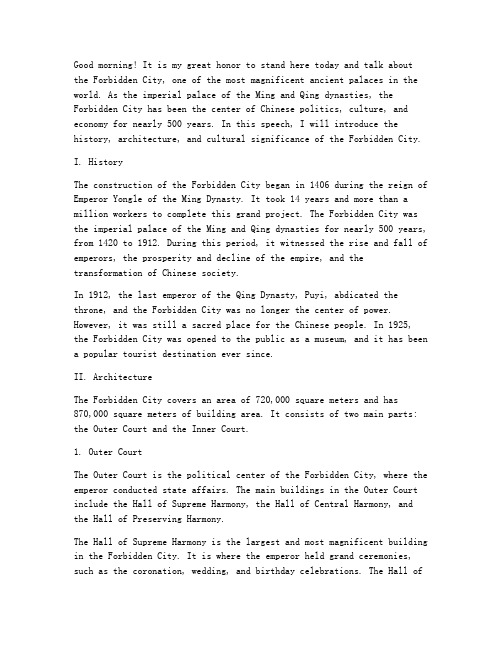
Good morning! It is my great honor to stand here today and talk about the Forbidden City, one of the most magnificent ancient palaces in the world. As the imperial palace of the Ming and Qing dynasties, the Forbidden City has been the center of Chinese politics, culture, and economy for nearly 500 years. In this speech, I will introduce the history, architecture, and cultural significance of the Forbidden City.I. HistoryThe construction of the Forbidden City began in 1406 during the reign of Emperor Yongle of the Ming Dynasty. It took 14 years and more than a million workers to complete this grand project. The Forbidden City was the imperial palace of the Ming and Qing dynasties for nearly 500 years, from 1420 to 1912. During this period, it witnessed the rise and fall of emperors, the prosperity and decline of the empire, and the transformation of Chinese society.In 1912, the last emperor of the Qing Dynasty, Puyi, abdicated the throne, and the Forbidden City was no longer the center of power. However, it was still a sacred place for the Chinese people. In 1925, the Forbidden City was opened to the public as a museum, and it has been a popular tourist destination ever since.II. ArchitectureThe Forbidden City covers an area of 720,000 square meters and has870,000 square meters of building area. It consists of two main parts: the Outer Court and the Inner Court.1. Outer CourtThe Outer Court is the political center of the Forbidden City, where the emperor conducted state affairs. The main buildings in the Outer Court include the Hall of Supreme Harmony, the Hall of Central Harmony, and the Hall of Preserving Harmony.The Hall of Supreme Harmony is the largest and most magnificent building in the Forbidden City. It is where the emperor held grand ceremonies, such as the coronation, wedding, and birthday celebrations. The Hall ofCentral Harmony is where the emperor prepared for his official duties. The Hall of Preserving Harmony is used for imperial banquets and audiences.2. Inner CourtThe Inner Court is the private residence of the emperor and his family. It is smaller and more intimate than the Outer Court. The main buildings in the Inner Court include the Palace of Heavenly Purity, the Palace of Earthly Tranquility, and the Palace of Union.The Palace of Heavenly Purity is the main hall of the Inner Court, where the emperor lived and conducted his daily affairs. The Palace of Earthly Tranquility is the residence of the empress, and the Palace of Union is the imperial garden.The architecture of the Forbidden City is characterized by its grandeur, symmetry, and harmony. The buildings are arranged in a strict order, following the principle of "front palace, back garden." The walls and gates are built in a unique style, with ornate decorations and inscriptions. The layout of the Forbidden City is also influenced by the Chinese geomancy, which emphasizes the harmony between man and nature.III. Cultural SignificanceThe Forbidden City is not only a historical site but also a cultural symbol of China. It embodies the traditional Chinese philosophy, art, and social system.1. PhilosophyThe Forbidden City reflects the Confucian philosophy of hierarchy and order. The emperors were considered the sons of heaven, and they ruled the country with the mandate of heaven. The architecture of the Forbidden City demonstrates the social hierarchy, with the emperor at the top of the pyramid.2. ArtThe Forbidden City is a treasure trove of Chinese art. The buildings are adorned with exquisite carvings, paintings, and calligraphy. The decorations and sculptures reflect the rich artistic traditions of China, such as the Ming and Qing styles.3. Social SystemThe Forbidden City is a microcosm of the ancient Chinese social system. The layout of the buildings and the arrangement of the staff reflect the strict division of labor and social status. The emperor and his family lived in the Inner Court, while the ministers and eunuchs lived in the Outer Court.In conclusion, the Forbidden City is a magnificent masterpiece ofancient Chinese architecture and culture. It represents the pinnacle of Chinese civilization and the essence of Chinese values. As we visit this grand palace, we can appreciate the wisdom and creativity of our ancestors and gain a deeper understanding of Chinese history and culture.Thank you for your attention!。
英语中国建筑演讲稿范文
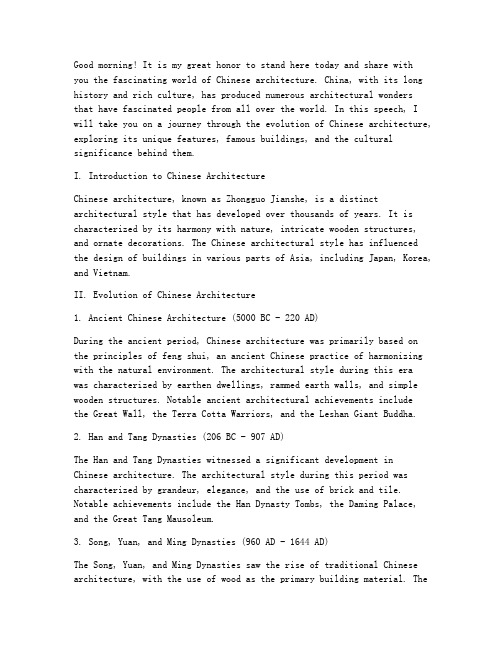
Good morning! It is my great honor to stand here today and share withyou the fascinating world of Chinese architecture. China, with its long history and rich culture, has produced numerous architectural wondersthat have fascinated people from all over the world. In this speech, I will take you on a journey through the evolution of Chinese architecture, exploring its unique features, famous buildings, and the cultural significance behind them.I. Introduction to Chinese ArchitectureChinese architecture, known as Zhongguo Jianshe, is a distinct architectural style that has developed over thousands of years. It is characterized by its harmony with nature, intricate wooden structures, and ornate decorations. The Chinese architectural style has influenced the design of buildings in various parts of Asia, including Japan, Korea, and Vietnam.II. Evolution of Chinese Architecture1. Ancient Chinese Architecture (5000 BC - 220 AD)During the ancient period, Chinese architecture was primarily based on the principles of feng shui, an ancient Chinese practice of harmonizing with the natural environment. The architectural style during this era was characterized by earthen dwellings, rammed earth walls, and simple wooden structures. Notable ancient architectural achievements includethe Great Wall, the Terra Cotta Warriors, and the Leshan Giant Buddha.2. Han and Tang Dynasties (206 BC - 907 AD)The Han and Tang Dynasties witnessed a significant development in Chinese architecture. The architectural style during this period was characterized by grandeur, elegance, and the use of brick and tile. Notable achievements include the Han Dynasty Tombs, the Daming Palace, and the Great Tang Mausoleum.3. Song, Yuan, and Ming Dynasties (960 AD - 1644 AD)The Song, Yuan, and Ming Dynasties saw the rise of traditional Chinese architecture, with the use of wood as the primary building material. Thearchitectural style during this period was characterized by intricate wooden structures, ornate decorations, and the integration of religious and philosophical elements. Notable achievements include the Forbidden City, the Summer Palace, and the Great Wall of China.4. Qing Dynasty (1644 AD - 1912 AD)The Qing Dynasty was marked by the continued development of traditional Chinese architecture, with an emphasis on intricate designs and the use of colored glazes. Notable achievements include the Summer Palace, the Confucius Temple, and the Yungang Grottoes.III. Unique Features of Chinese Architecture1. Wooden StructuresWooden structures are the backbone of Chinese architecture. Chinese builders have developed sophisticated techniques for joinery and construction, allowing for the creation of grand and durable buildings. The use of wood also allows for flexibility and adaptability, making it an ideal material for various architectural styles.2. Feng ShuiFeng shui is an essential aspect of Chinese architecture. It involves the arrangement of buildings and spaces in harmony with the natural environment. Feng shui principles aim to achieve a balance between the human and the natural world, promoting health, wealth, and prosperity.3. Decorative ElementsChinese architecture is rich in decorative elements, including intricate carvings, murals, and calligraphy. These elements often depict scenes from Chinese mythology, history, and literature, reflecting thecountry's cultural heritage.4. Hierarchical StructureChinese architecture often reflects the social hierarchy of the time. For example, the Forbidden City, the imperial palace of the Ming andQing Dynasties, showcases the grandeur and power of the emperor, withits intricate designs and vast expanse.IV. Famous Chinese Buildings1. The Forbidden CityThe Forbidden City, located in Beijing, is the most iconic symbol of Chinese architecture. It was the imperial palace of the Ming and Qing Dynasties and served as the political and ceremonial center of the country for nearly 500 years. The Forbidden City is a masterpiece of traditional Chinese architecture, showcasing the grandeur and majesty of the imperial power.2. The Great Wall of ChinaThe Great Wall of China is one of the most famous architectural wonders in the world. It is a series of fortifications built to protect the Chinese Empire against invasions from various nomadic groups. The Great Wall stretches over 13,000 miles and is a testament to the architectural and engineering skills of ancient Chinese builders.3. The Summer PalaceThe Summer Palace, located in Beijing, is a masterpiece of Chinese garden design and architecture. It was built during the Qing Dynasty as a retreat for the imperial family. The Summer Palace combinestraditional Chinese architecture with beautiful gardens, lakes, and pavilions, creating a serene and picturesque environment.V. ConclusionIn conclusion, Chinese architecture is a testament to the rich cultural heritage and architectural ingenuity of the Chinese people. From the ancient earthen dwellings to the grand palaces and temples of the dynasties, Chinese architecture has evolved over thousands of years, reflecting the country's history, culture, and values. Today, Chinese architecture continues to inspire architects and designers around the world, and its unique features and beautiful designs remain a source of pride and fascination for all.Thank you for your attention.。
建筑工程自我介绍(5篇)

建筑工程自我介绍(5篇)(经典版)编制人:__________________审核人:__________________审批人:__________________编制单位:__________________编制时间:____年____月____日序言下载提示:该文档是本店铺精心编制而成的,希望大家下载后,能够帮助大家解决实际问题。
文档下载后可定制修改,请根据实际需要进行调整和使用,谢谢!并且,本店铺为大家提供各种类型的经典范文,如演讲稿、总结报告、合同协议、方案大全、工作计划、学习计划、条据书信、致辞讲话、教学资料、作文大全、其他范文等等,想了解不同范文格式和写法,敬请关注!Download tips: This document is carefully compiled by this editor.I hope that after you download it, it can help you solve practical problems. The document can be customized and modified after downloading, please adjust and use it according to actual needs, thank you!In addition, this shop provides you with various types of classic sample essays, such as speech drafts, summary reports, contract agreements, project plans, work plans, study plans, letter letters, speeches, teaching materials, essays, other sample essays, etc. Want to know the format and writing of different sample essays, so stay tuned!建筑工程自我介绍(5篇)建筑工程自我介绍(5篇)建筑工程,指通过对各类房屋建筑及其附属设施的建造和与其配套的线路、管道、设备的安装活动所形成的工程实体。
建筑专业英语作文范文
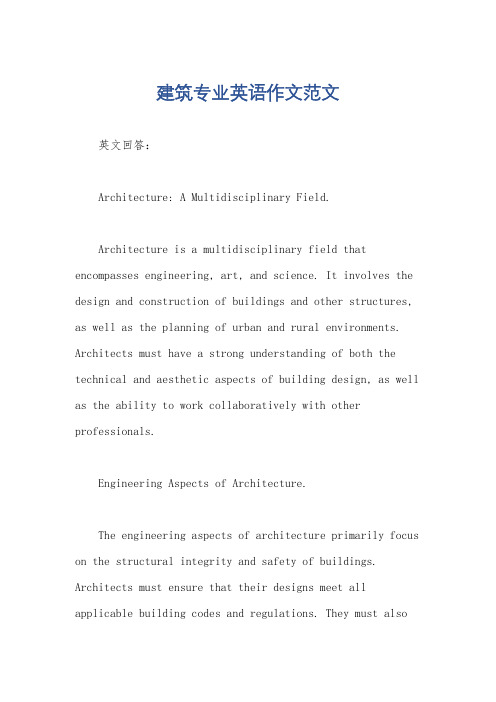
建筑专业英语作文范文英文回答:Architecture: A Multidisciplinary Field.Architecture is a multidisciplinary field that encompasses engineering, art, and science. It involves the design and construction of buildings and other structures, as well as the planning of urban and rural environments. Architects must have a strong understanding of both the technical and aesthetic aspects of building design, as well as the ability to work collaboratively with other professionals.Engineering Aspects of Architecture.The engineering aspects of architecture primarily focus on the structural integrity and safety of buildings. Architects must ensure that their designs meet all applicable building codes and regulations. They must alsoconsider factors such as environmental loads (e.g., wind, snow, earthquakes) and the materials used in construction. Structural engineers play a vital role in the design process, ensuring that buildings are safe and habitable.Art and Aesthetic Aspects of Architecture.In addition to engineering considerations, architects must also pay attention to the aesthetic aspects of their designs. Buildings should be visually appealing and reflect the needs and desires of their users. Architects must consider factors such as the building's form, color, and texture, as well as the relationship between the building and its surroundings. Interior designers play a key role in the aesthetic aspects of architecture, creating spaces that are both functional and visually pleasing.Science and Sustainability in Architecture.Recent advances in science and technology have had a significant impact on architecture. Architects are now able to design buildings that are more energy-efficient,sustainable, and environmentally friendly. Green building practices, such as using recycled materials and incorporating renewable energy sources, are becoming increasingly common. Architects must be aware of the latest scientific advancements and incorporate sustainable principles into their designs.Collaboration and Teamwork in Architecture.Architecture is a collaborative field, and architects must be able to work effectively with a variety of professionals, including engineers, contractors, and clients. They must be able to communicate their ideas clearly and concisely, and they must be able to work within a team environment. Architects must also be able to adapt their designs to the needs of their clients and the constraints of the site.Importance of Architecture.Architecture is essential for creating livable and sustainable communities. Buildings provide shelter,protection, and a sense of place. They can also contribute to the social and economic well-being of a community. Well-designed buildings can improve air quality, reduce crime, and promote physical and mental health. Architects have a responsibility to design buildings that are safe, sustainable, and aesthetically pleasing.中文回答:建筑学,一门多学科领域。
关于介绍建筑英语演讲稿5篇
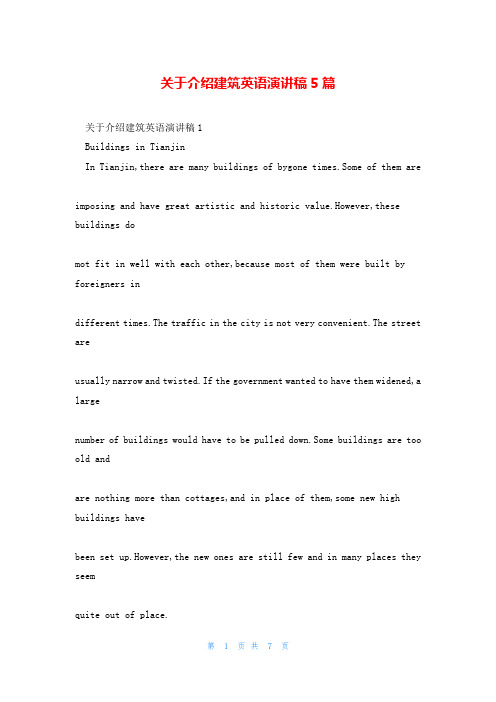
关于介绍建筑英语演讲稿5篇关于介绍建筑英语演讲稿1Buildings in TianjinIn Tianjin,there are many buildings of bygone times.Some of them areimposing and have great artistic and historic value.However,these buildings domot fit in well with each other,because most of them were built by foreigners indifferent times.The traffic in the city is not very convenient.The street areusually narrow and twisted.If the government wanted to have them widened,a largenumber of buildings would have to be pulled down.Some buildings are too old andare nothing more than cottages,and in place of them,some new high buildings havebeen set up.However,the new ones are still few and in many places they seemquite out of place.Yet those Western-style buildings give Tianjin a different characteristicfrom other cities and those new ones lend the city fresh vitality which willspread rapidly with the reform going on.关于介绍建筑英语演讲稿2Alright, well I ve been asked to talk about something beautiful and I dlike to choose the White Cloud Temple. It is located in Beijing and it s on thewest side of town. It s not that far away from a subway station, but you wouldneed to take a bus, because it s a bit far to walk. I go there probably two ormore times a year. It s a Taoist temple, probably the most active Taoist templein Beijing. I m a Taoist. But I go there more than just to pray. I really try totake a trip to find some time to rediscover myself. During the Spring Festivalpeople jam into it because they hold what I think is the best carnival duringSpring Festival. We call them Miao Huis. At that time the temple is verycrowded, but most other times it s quite peaceful, and it s a good place to getaway from all the people.I think the reason it s so beautiful is because it is simple and it seemsto blend in well with its environment. The small praying hall is very serene. Ithas a nice pool and a bridge. The Taoist motifs are quite simple but I thinkthey are very charming. I love to go there during the winter after a bigsnowfall because it s at this time that it seems to be most mysterious.I choosethis as the most beautiful because, to me, beauty is simplicity and naturaldesign, and it also means it fits the environment it is in. I don t really likegrand, elaborate temples. I prefer temples that seem powerful not because oftheir structures but because they are perfect for their simple beauty. 关于介绍建筑英语演讲稿3Foshan is located in south of daxian daxian really more than 30 kilometersin the middle of the gorge seven mountains are good at an altitude ofterritory,township,QuanShan 910 area approximately 3,000 mu,is a famed buddhistresort.According to records,the qing qianlong editing practice,farmersChiang,one side dehua practicing medicine fulfillment,called Chianggood , jiang living buddhas,self-built dehua temple .After the sun to setmansion magistrate was to ask the rightful heir,convinced that he is spiritand ordered a true buddhist temple,and book of expansion foshan engraved ontemple gate,which name.True foshan,from the bottom of the hill to thesteep,conifers,ZhuLiang eaves tightly wound up,have 1000 steps out,likethesteps of straight down and a ladder for his ascent,air force,the upward sideofspicy camphor pines cypresses scene.关于介绍建筑英语演讲稿4The Great Wall of China is the largest earth work in the world. Like a longsnake it winds its way from Shanhaiguan Pass on the east coast to Jiayuguan Passin the Gobi desert. The main part of the wall is about 2150miles long. It didn tbecome the Great Wall until the Qin Dynasty. Qin Shihuang ordered his peopleto connect the separate walls. In order to prevent enemies out of China. Eachdynasty added to the wall s height and lenght. It didn t reach 6400 kilometerslong until Min Dynasty. Now the Great Wall is a world-famous tourist attraction.It s the symbol of the wisdom of the ancient Chinese.关于介绍建筑英语演讲稿5The Ancient ArchitectureChinese architecture is an independent art featuring wooden structures. Itconsists of various roof molding, upturned eaves and wings, dougong withpaintings, vermilion pillars and golden roofs, ornament gates and gardening. Allof these embody the maturity and artistic appeal of Chinese architecture. 7000years ago, mortise and tenon and tongue-and-groove were used in Hemudu. Thebuildings of Banpo village had the division of antechamber and back rooms. Greatpalaces were built in Shangyin period. Bricks and tiles were used and the layoutof Siheyuan emerged in the Western Zhou. There are even building drawings inSpring and Autumn and the Warring States periods passed down.In Qin and Han, wooden building tended to be mature gradually. Complexbuildings, like Epang Palace, were constructed. Temples and pagodas developedrapidly in the period of Weijin and Southern and Northern dynasties. Glass tilesused in Sui and Tang made the building more glorious. The city construction inthe period of Five dynasties and Song was booming. Luxury restaurants and shopswith lofts and railings were very beautiful. Many palaces and private gardensbuilt in Ming and Qing are reserved today, which are more magnificent andstately than that of the Song Dynasty.关于介绍建筑英语演讲稿。
介绍建筑作文英语高中
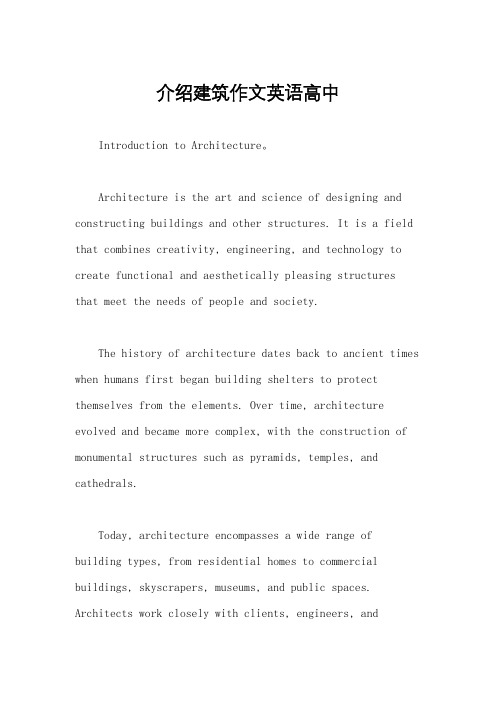
介绍建筑作文英语高中Introduction to Architecture。
Architecture is the art and science of designing and constructing buildings and other structures. It is a field that combines creativity, engineering, and technology to create functional and aesthetically pleasing structuresthat meet the needs of people and society.The history of architecture dates back to ancient times when humans first began building shelters to protect themselves from the elements. Over time, architecture evolved and became more complex, with the construction of monumental structures such as pyramids, temples, and cathedrals.Today, architecture encompasses a wide range ofbuilding types, from residential homes to commercial buildings, skyscrapers, museums, and public spaces. Architects work closely with clients, engineers, andcontractors to design buildings that are safe, efficient, and sustainable.The Process of Architecture。
建筑工人英语演讲稿范文
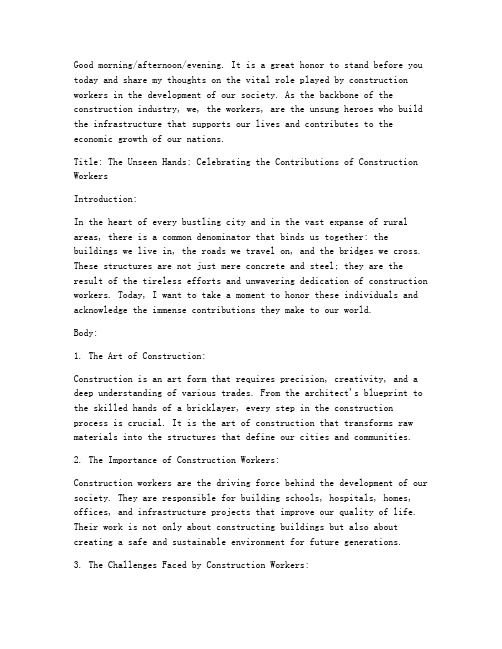
Good morning/afternoon/evening. It is a great honor to stand before you today and share my thoughts on the vital role played by construction workers in the development of our society. As the backbone of the construction industry, we, the workers, are the unsung heroes who build the infrastructure that supports our lives and contributes to the economic growth of our nations.Title: The Unseen Hands: Celebrating the Contributions of Construction WorkersIntroduction:In the heart of every bustling city and in the vast expanse of rural areas, there is a common denominator that binds us together: the buildings we live in, the roads we travel on, and the bridges we cross. These structures are not just mere concrete and steel; they are the result of the tireless efforts and unwavering dedication of construction workers. Today, I want to take a moment to honor these individuals and acknowledge the immense contributions they make to our world.Body:1. The Art of Construction:Construction is an art form that requires precision, creativity, and a deep understanding of various trades. From the architect's blueprint to the skilled hands of a bricklayer, every step in the construction process is crucial. It is the art of construction that transforms raw materials into the structures that define our cities and communities.2. The Importance of Construction Workers:Construction workers are the driving force behind the development of our society. They are responsible for building schools, hospitals, homes, offices, and infrastructure projects that improve our quality of life. Their work is not only about constructing buildings but also about creating a safe and sustainable environment for future generations.3. The Challenges Faced by Construction Workers:Despite the vital role they play, construction workers often face numerous challenges. These include long hours, physically demanding work, and sometimes hazardous conditions. They work in all weather conditions, often away from their families, and sometimes in dangerous situations. Yet, they continue to put in their best efforts, driven by the satisfaction of seeing their work transform into reality.4. The Skills and Expertise:Construction workers possess a wide range of skills and expertise. They are masters of their trades, from carpenters and electricians to plumbers and HVAC technicians. Their knowledge and experience enable them to handle complex projects and ensure that every detail is executed to perfection.5. The Impact on the Economy:The construction industry is a significant contributor to the global economy. It creates jobs, stimulates economic growth, and provides a pathway to financial stability for millions of people. Construction workers are the lifeblood of this industry, and their contributions cannot be overstated.6. The Role of Safety:Safety is paramount in the construction industry. Construction workers are trained to follow strict safety protocols to prevent accidents and ensure a healthy work environment. Their dedication to safety not only protects themselves but also their colleagues and the public.7. The Future of Construction:As technology advances, the construction industry is evolving. New methods, materials, and tools are being introduced to make the process more efficient and sustainable. Construction workers must adapt to these changes and continue to develop their skills to stay relevant in anever-changing industry.Conclusion:In conclusion, construction workers are the unsung heroes of our society. They are the unseen hands that shape the world we live in. Their contributions are invaluable, and their dedication deserves our recognition and respect. As we celebrate the achievements of the construction industry, let us also honor the men and women who work tirelessly to build a better future for us all.Thank you for listening, and let us continue to support and appreciate the hardworking individuals who construct the foundations of our civilization.[Note: This speech is a general framework and can be tailored tospecific events or themes relevant to construction workers.]。
中华建筑英语演讲稿范文
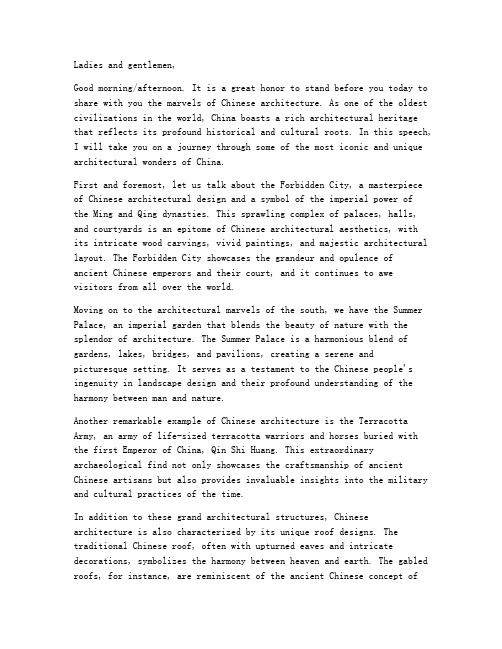
Ladies and gentlemen,Good morning/afternoon. It is a great honor to stand before you today to share with you the marvels of Chinese architecture. As one of the oldest civilizations in the world, China boasts a rich architectural heritage that reflects its profound historical and cultural roots. In this speech, I will take you on a journey through some of the most iconic and unique architectural wonders of China.First and foremost, let us talk about the Forbidden City, a masterpiece of Chinese architectural design and a symbol of the imperial power ofthe Ming and Qing dynasties. This sprawling complex of palaces, halls, and courtyards is an epitome of Chinese architectural aesthetics, withits intricate wood carvings, vivid paintings, and majestic architectural layout. The Forbidden City showcases the grandeur and opulence ofancient Chinese emperors and their court, and it continues to awevisitors from all over the world.Moving on to the architectural marvels of the south, we have the Summer Palace, an imperial garden that blends the beauty of nature with the splendor of architecture. The Summer Palace is a harmonious blend of gardens, lakes, bridges, and pavilions, creating a serene andpicturesque setting. It serves as a testament to the Chinese people's ingenuity in landscape design and their profound understanding of the harmony between man and nature.Another remarkable example of Chinese architecture is the Terracotta Army, an army of life-sized terracotta warriors and horses buried with the first Emperor of China, Qin Shi Huang. This extraordinary archaeological find not only showcases the craftsmanship of ancient Chinese artisans but also provides invaluable insights into the military and cultural practices of the time.In addition to these grand architectural structures, Chinesearchitecture is also characterized by its unique roof designs. The traditional Chinese roof, often with upturned eaves and intricate decorations, symbolizes the harmony between heaven and earth. The gabled roofs, for instance, are reminiscent of the ancient Chinese concept of"merging heaven and earth," with the two sides of the roof representing the mountains that support the sky.Furthermore, Chinese architecture is deeply rooted in its cultural and philosophical traditions. The layout of ancient Chinese buildings often follows the principle of "feng shui," an ancient Chinese practice that aims to harmonize the building with its surroundings. This principle is evident in the design of many traditional Chinese gardens and temples, which are carefully arranged to create a harmonious and serene environment.In conclusion, Chinese architecture is a treasure trove of artistic and cultural heritage. From the majestic Forbidden City to the serene Summer Palace, from the life-sized Terracotta Army to the intricate roof designs, Chinese architecture embodies the spirit and wisdom of the Chinese people. It is a testament to the enduring legacy of acivilization that has thrived for thousands of years, and it continues to inspire and captivate the world today.Thank you for your attention, and I hope this brief overview has given you a glimpse into the marvels of Chinese architecture.。
介绍建筑的英语作文

介绍建筑的英语作文Title: Exploring the World of Architecture。
Architecture, as a discipline, stands at the intersection of art, science, and culture. It is the art and science of designing and constructing buildings and other physical structures that serve both functional and aesthetic purposes. Throughout history, architecture has played a crucial role in shaping societies and reflecting the values and aspirations of civilizations. In this essay, we will delve into the fascinating world of architecture, exploring its history, principles, and significance.Historical Evolution of Architecture:The history of architecture is a journey through time, reflecting the evolution of human civilization. From the ancient wonders of the world, such as the Great Pyramid of Giza and the Parthenon, to the modern skyscrapers that dominate urban skylines, architecture has evolved inresponse to technological advancements, cultural influences, and societal needs.Ancient civilizations, such as the Egyptians, Greeks, and Romans, made significant contributions to architectural innovation. The Egyptians built monumental structures, such as pyramids and temples, using massive stone blocks and precise engineering techniques. Greek architecture introduced the concepts of harmony, proportion, and symmetry, as exemplified in iconic structures like the Acropolis. The Romans further advanced architectural engineering with their mastery of arches, domes, and concrete, creating enduring landmarks like the Colosseumand the Pantheon.The Middle Ages witnessed the rise of Gothic architecture, characterized by soaring cathedrals adorned with intricate stone carvings and stained glass windows.The Renaissance period saw a revival of classical ideals, leading to the construction of palaces, churches, and civic buildings inspired by the architecture of ancient Greeceand Rome.The Industrial Revolution brought about a revolution in architectural design and construction methods, ushering in an era of skyscrapers, steel frames, and mass production. Modern architects, such as Frank Lloyd Wright, Le Corbusier, and Ludwig Mies van der Rohe, embraced new materials and technologies to create innovative buildings that redefined the urban landscape.Principles of Architecture:At its core, architecture is guided by fundamental principles that govern the design process. These principles encompass both aesthetic considerations and functional requirements, ensuring that buildings are not only visually appealing but also practical and sustainable.Balance and proportion are essential principles in architectural design, ensuring harmony and coherence in the arrangement of elements. Symmetry, asymmetry, and rhythmare used to create visual interest and balance within a structure. Scale refers to the relationship between thesize of architectural elements and the human body, ensuring that buildings feel comfortable and inviting to occupants.Functionality is another key principle of architecture, as buildings must fulfill the needs and activities of their users. Architects must consider factors such as spatial organization, circulation, and accessibility when designing buildings for residential, commercial, or institutional use.In addition to functionality, sustainability has become an increasingly important consideration in modern architecture. Architects are incorporating environmentally friendly design strategies, such as passive solar heating, natural ventilation, and green roofs, to reduce energy consumption and minimize the environmental impact of buildings.Significance of Architecture:Architecture plays a profound role in shaping the built environment and influencing the quality of life for individuals and communities. Well-designed buildings caninspire awe, foster social interaction, and enhance the human experience. They serve as landmarks that define the identity of cities and serve as symbols of cultural heritage and civic pride.Furthermore, architecture has the power to address pressing societal challenges, such as urbanization, climate change, and social inequality. By designing sustainable, resilient, and inclusive spaces, architects can contribute to creating more livable and equitable cities for future generations.In conclusion, architecture is a dynamic and multifaceted discipline that encompasses art, science, and culture. From ancient wonders to modern marvels, architecture reflects the creativity, ingenuity, and aspirations of humanity. By understanding the historical evolution, principles, and significance of architecture, we gain a deeper appreciation for the built environment that surrounds us and the impact it has on our lives.。
备战高考英语作文满分突破真题讲解:第19期 话题10 中国传统文化 中国园林介绍

人景合一的独特设计理念
罗列要点、连词成句
Para.3 1.简要介绍中国园林建筑;
The Chinese classical garden is a precious treasure of our ancient Chinese architecture. It is a kind of environment art, which systematically combines artificial mountains and rivers, plants and buildings with the natural landscape. 中国园林把人造的山水、植物、建筑等与自然地貌有机结合的环境艺术, 是我国古代建筑艺术的珍宝。
The Chinese classical garden is a precious treasure of our ancient Chinese architecture. It is a kind of environment art, which systematically combines artificial mountains and rivers, plants and buildings with the natural landscape. The construction standard of a Chinese classical garden is “Artificial as it is, the garden must look ingenious and natural.”
从现在到一模考试前,主要任务是过课本、串教材,把基础知识再夯实, 为专题复习奠定坚实基础。各学科组教师要认真学习新课程、新课标、《中国 考试评价体系及说明》和近三年高考原题,把高考考点和试题变化点做成“作战 地图”,平时考试、练习要对照“作战地图”进行选题,并在“作战地图”上一一标 注,确保考点训练无死角、考点覆盖无遗漏。 二是组织集体攻坚
英语演讲介绍什么
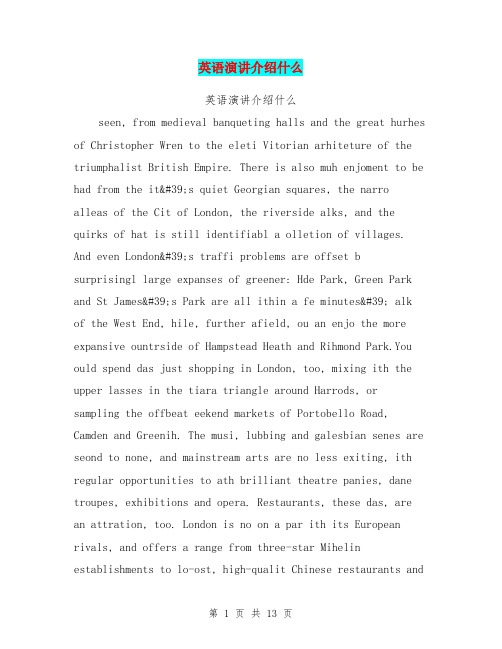
英语演讲介绍什么英语演讲介绍什么seen, from medieval banqueting halls and the great hurhes of Christopher Wren to the eleti Vitorian arhiteture of the triumphalist British Empire. There is also muh enjoment to be had from the it's quiet Georgian squares, the narroalleas of the Cit of London, the riverside alks, and the quirks of hat is still identifiabl a olletion of villages. And even London's traffi problems are offset bsurprisingl large expanses of greener: Hde Park, Green Park and St James's Park are all ithin a fe minutes' alkof the West End, hile, further afield, ou an enjo the more expansive ountrside of Hampstead Heath and Rihmond Park.You ould spend das just shopping in London, too, mixing ith the upper lasses in the tiara triangle around Harrods, or sampling the offbeat eekend markets of Portobello Road, Camden and Greenih. The musi, lubbing and galesbian senes are seond to none, and mainstream arts are no less exiting, ith regular opportunities to ath brilliant theatre panies, dane troupes, exhibitions and opera. Restaurants, these das, are an attration, too. London is no on a par ith its European rivals, and offers a range from three-star Mihelin establishments to lo-ost, high-qualit Chinese restaurants andIndian urr houses. Meanhile, the it's pubs have heaps of atmosphere, espeiall XX from the entre – and an exploration of the farther-flung munities is essential to get the plete piture of this dnami metropolis. 有着不到八百万的人口,伦敦是欧洲最大的城市,以泰晤士河为中心纵横620平方英里。
建筑专业英语作文模板
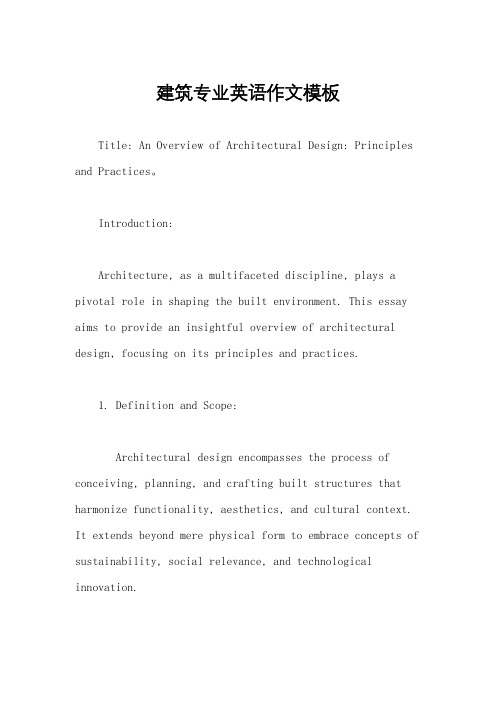
建筑专业英语作文模板Title: An Overview of Architectural Design: Principles and Practices。
Introduction:Architecture, as a multifaceted discipline, plays a pivotal role in shaping the built environment. This essay aims to provide an insightful overview of architectural design, focusing on its principles and practices.1. Definition and Scope:Architectural design encompasses the process of conceiving, planning, and crafting built structures that harmonize functionality, aesthetics, and cultural context. It extends beyond mere physical form to embrace concepts of sustainability, social relevance, and technological innovation.2. Principles of Architectural Design:a. Functionality: Architecture should fulfill the intended purpose of the structure efficiently and effectively.b. Aesthetics: Design should evoke emotional responses, create visual interest, and contribute to the overall beauty of the built environment.c. Sustainability: Embracing sustainable practices ensures minimal environmental impact and long-term viability.d. Contextual Integration: Buildings should respond sensitively to their surroundings, be it natural landscapes or urban settings.e. User Experience: Prioritizing the needs and experiences of occupants enhances usability and fosters a sense of well-being.3. Architectural Design Process:a. Research and Analysis: Understanding project requirements, site conditions, and cultural context through thorough research and analysis.b. Conceptualization: Generating innovative design concepts that address functional, aesthetic, and contextual considerations.c. Development: Refining the chosen concept through iterative design iterations, incorporating feedback from stakeholders.d. Documentation: Creating detailed architectural drawings, specifications, and documentation for construction and regulatory approval.e. Implementation: Overseeing constructionactivities to ensure adherence to design intent and quality standards.f. Evaluation: Assessing the performance of the completed structure in terms of functionality, sustainability, and user satisfaction.4. Emerging Trends in Architectural Design:a. Sustainability: Increasing emphasis on green building practices, renewable energy integration, and passive design strategies.b. Digital Fabrication: Leveraging advanced technologies such as 3D printing and robotic construction for innovative design solutions.c. Biophilic Design: Incorporating elements of nature into built environments to enhance well-being and connection to the natural world.d. Adaptive Reuse: Repurposing existing structures for new functions, promoting resource conservation and preservation of cultural heritage.e. Smart Buildings: Integration of IoT (Internet of Things) devices and sensors for enhanced building performance, occupant comfort, and energy efficiency.Conclusion:Architectural design is a dynamic field that continues to evolve in response to changing societal needs, technological advancements, and environmental challenges. By adhering to fundamental principles while embracing innovation, architects can create spaces that inspire, enrich, and sustain communities for generations to come.。
介绍建筑作文英语作文
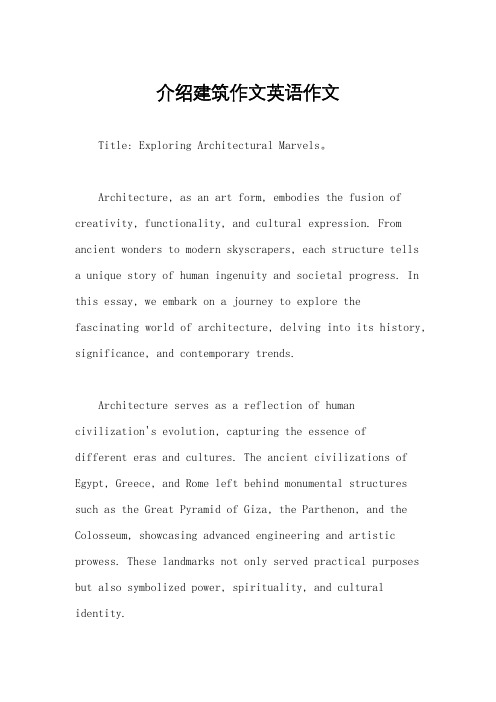
介绍建筑作文英语作文Title: Exploring Architectural Marvels。
Architecture, as an art form, embodies the fusion of creativity, functionality, and cultural expression. From ancient wonders to modern skyscrapers, each structure tells a unique story of human ingenuity and societal progress. In this essay, we embark on a journey to explore thefascinating world of architecture, delving into its history, significance, and contemporary trends.Architecture serves as a reflection of humancivilization's evolution, capturing the essence ofdifferent eras and cultures. The ancient civilizations of Egypt, Greece, and Rome left behind monumental structures such as the Great Pyramid of Giza, the Parthenon, and the Colosseum, showcasing advanced engineering and artistic prowess. These landmarks not only served practical purposes but also symbolized power, spirituality, and cultural identity.Moving forward in time, the medieval period witnessed the rise of Gothic architecture, characterized by soaring cathedrals adorned with intricate sculptures and stained glass windows. These architectural marvels, like Notre-Dame Cathedral in Paris, not only served as places of worshipbut also inspired awe and reverence, reflecting thespiritual aspirations of medieval society.The Renaissance era ushered in a revival of classical architectural principles, with architects like Leonardo da Vinci and Michelangelo reinterpreting ancient forms and proportions. The result was a harmonious blend of symmetry, proportion, and beauty, exemplified by iconic structures such as St. Peter's Basilica in Vatican City and thePalazzo Vecchio in Florence.The Industrial Revolution brought about significant changes in architectural design and construction techniques. The advent of steel and reinforced concrete enabled the creation of taller buildings, giving birth to the modern skyscraper. Architects like Louis Sullivan and Frank LloydWright embraced new materials and technologies to create innovative structures that redefined city skylines, such as the iconic Empire State Building in New York City and the Fallingwater house in Pennsylvania.In the 20th and 21st centuries, architecture has continued to evolve, embracing diverse styles and ideologies. The modernist movement, led by architects like Le Corbusier and Ludwig Mies van der Rohe, emphasized simplicity, functionality, and the use of industrial materials. This approach gave rise to minimalist structures such as the Bauhaus School in Germany and the Seagram Building in New York City.Contemporary architecture encompasses a wide range of styles, from the avant-garde designs of Zaha Hadid to the sustainable practices of firms like Foster + Partners. Green architecture, characterized by eco-friendly materials and energy-efficient design, has gained prominence in response to environmental concerns. Examples include the Bosco Verticale in Milan and the One Central Park in Sydney, which integrate vegetation into their facades to promotebiodiversity and reduce carbon emissions.In conclusion, architecture is not merely about erecting buildings but about shaping the built environment in harmony with nature and society. It is a reflection of our aspirations, values, and aspirations as a civilization. By studying architectural masterpieces from different eras and cultures, we gain insights into the human condition and the enduring quest for beauty, functionality, and meaningin our built environment.。
英文介绍建筑专业的作文
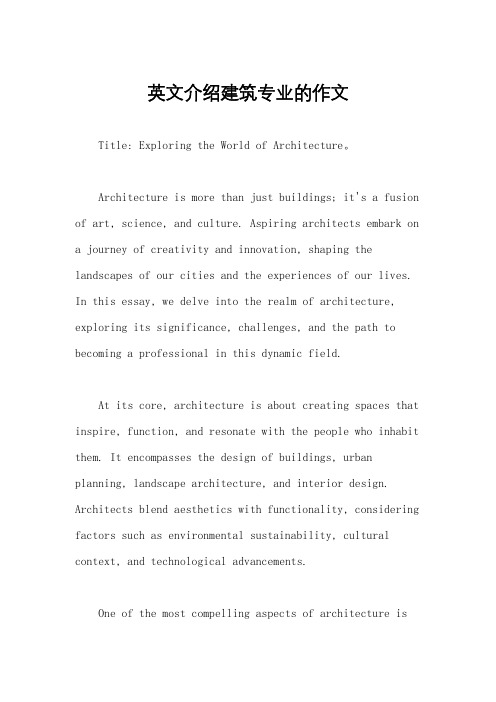
英文介绍建筑专业的作文Title: Exploring the World of Architecture。
Architecture is more than just buildings; it's a fusion of art, science, and culture. Aspiring architects embark on a journey of creativity and innovation, shaping the landscapes of our cities and the experiences of our lives. In this essay, we delve into the realm of architecture, exploring its significance, challenges, and the path to becoming a professional in this dynamic field.At its core, architecture is about creating spaces that inspire, function, and resonate with the people who inhabit them. It encompasses the design of buildings, urban planning, landscape architecture, and interior design. Architects blend aesthetics with functionality, considering factors such as environmental sustainability, cultural context, and technological advancements.One of the most compelling aspects of architecture isits ability to reflect the values and aspirations of society. From ancient civilizations to modern metropolises, architectural styles evolve in response to cultural, political, and technological shifts. Gothic cathedrals, Renaissance palaces, and contemporary skyscrapers each tell a story of their time, capturing the spirit of an era through design.However, the journey to becoming an architect is not without its challenges. It requires a unique blend of creativity, technical skills, and perseverance. Architectural education is rigorous, encompassing studies in design theory, structural engineering, building materials, and computer-aided design (CAD). Students spend countless hours honing their craft, from sketching initial concepts to constructing detailed models and digital renderings.Beyond the classroom, aspiring architects often face obstacles in navigating the complexities of the industry. Competition for internships and entry-level positions can be fierce, requiring graduates to demonstrate their talentand dedication. Additionally, the path to licensure involves completing a period of practical experience and passing rigorous exams, ensuring that architects are equipped to uphold professional standards and ethics.Despite these challenges, the rewards of a career in architecture are immeasurable. Architects have the opportunity to shape the built environment, influencing how people interact with their surroundings on a daily basis. Whether designing a public plaza, a sustainable housing development, or a cultural landmark, architects play avital role in shaping the future of our cities and communities.Moreover, architecture offers a platform for interdisciplinary collaboration, bringing together professionals from diverse fields such as engineering, construction, and urban planning. By working collaboratively, architects can address complex challenges such as climate change, social equity, and urban sprawl, creating spaces that are both beautiful and functional.In conclusion, architecture is a dynamic and multifaceted profession that blends artistry with technical expertise. As architects, we have the privilege and responsibility to shape the world around us, creating spaces that enrich lives and inspire generations to come. By embracing creativity, innovation, and a commitment to excellence, we can harness the power of architecture to build a brighter future for all.。
- 1、下载文档前请自行甄别文档内容的完整性,平台不提供额外的编辑、内容补充、找答案等附加服务。
- 2、"仅部分预览"的文档,不可在线预览部分如存在完整性等问题,可反馈申请退款(可完整预览的文档不适用该条件!)。
- 3、如文档侵犯您的权益,请联系客服反馈,我们会尽快为您处理(人工客服工作时间:9:00-18:30)。
there is a story of architecture through humanity, and about beauty in simplicityand nature. today we will build an igloo together, a structure that reveals the origin ofarchitecture, when man first created shelter from hostile weather and prowlingbeasts. first we need a good snow. igloo, a creation of the inuit culture, was used as winter home and shelters onhunting expeditions. the people there still hunt, but few build igloos. then we draw a big circle on the ground. the master block, the foundation has to be placed facing towards the sunshine,because the sun gives us everything. the blocks are laid in a clockwise direction,following the motion of the sun as it moves though the sky from draw to dusk. the miracle of the igloo is that the weakest building material possible, frozenwater, achieve strength through brilliant engineering. after a couple of layers of blocks, the walls start sloping inward. the blocksstart to spar up and each block is cunningly shaped. it’s all together by a goodbit which sort of melts a bit of snow, and then that freezes. and it just stays firm.so it’s all being glued together with ice. constructing a dome without props or scaffolding is a perilous undertaking. thefinal stages are hazardous. problematic joins are fixed with intricate ice carpentry.and the familiar shape keeps on growing. antoni gaudí was a catalan architect of spanish. gaudís works reflecthis highly individual and distinctive style and are largely concentrated in thecatalan capital of barcelona, notably his magnum opus, the sagrada família. muchof gaudís work was marked by his big passions in life: architecture, nature,religion. gaudí studied every detail of his creations, integrating into hisarchitecture a series of crafts in which he was skilled: ceramics, stained glass,wrought ironwork forging and carpentry. he introduced new techniques in thetreatment of materials.after a few years, under the influence of neo-gothic art and oriental techniques,gaudí became part of the modernista movement which was reaching its peak in the late19th and early 20th centuries. his work transcended mainstream modernisme,culminating in an organic style inspired by nature. gaudí rarely drew detailed plansof his works, instead preferring to create them as three-dimensional scale models and molding the details as he was conceiving them. catalonia.[4] between 1984 and 2005, seven of his works were declared worldheritage sites by unesco. gaudís roman catholic faith intensified during his lifeand religious images permeate his work. this earned him the nickname gods architectand led to calls for his beatification. 篇三:建筑行业演讲稿传递正能量共筑中国梦尊敬的各位领导、评委老师、亲爱的朋友们:大家上午好!我是阿里山集团的***,今天我演讲的题目是《传递正能量共筑中国梦》。
四十一年前,一位17岁的农村青年背起行囊,来到*城。
起初在建筑队里,一没学历、二没技术的他只能做干活最累、收入最低的小工,每天的工作就是搬砖、和泥、为瓦匠师傅打下手。
他有一个简单的梦想,就是在*城这座城市里能够学到一技之长,安身立命。
虽然工作辛苦,但他却没有灰心,聪明好学的他总把工友打扑克下象棋的时间用来勤学苦练,没用多长时间,他就从小工晋级为三级瓦工,并进入了向阳建筑公司做了一名真正的建筑工人,有了一份虽然微薄但却稳定的收入。
第一次他切身感受到了国家政策的温暖,产生了对党和政府的热爱。
1978年,改革开放的春风吹遍了华夏大地。
这一年他被聘请为****公司三处一队的队长,开始了建筑承包。
他带领着自己的小队伍承建一些工程,盖瓦房、建学校、修公路……一点一滴、日积月累、小有成就。
也就是在那个时期,青年的心中更加坚定了对社会主义的信念、对党和政府的信任。
1998年,他领导的建筑队已搞得有声有色,而**建筑公司确因为机制不活走到了濒临倒闭的边缘,一帮职工面临失业没饭吃的窘境。
危难之际,主管部门的领导找到了他,经过一番深谈,他挑起了第四建筑公司的担子,走上了总经理的岗位,并亲手组建了阿里山建设集团。
当被问及为什么要接手这个烂摊子的时候,他说“这是党和政府对我的信任,我不能眼看着这么一帮人没饭吃。
相信在党和政府的领导下,我有信心带着阿里山人闯出个名堂来!”就是凭借着对社会主义的信念,怀揣着对党和政府的信任,经过十五年的打拼,他最终把一个负债累累、濒临倒闭的乡镇企业发展成为今天这个多项产业齐头并进的企业集团。
听到这里,相信各位已经猜到了我讲的是谁。
没错,他就是我们阿里山集团的掌舵人--***,一个被外界亲切地称之为“老*”的企业老总。
时光荏苒,41年光阴弹指一挥间,当时在公社建筑队干零工的毛头小伙子,如今已成为两鬓染霜的企业老总。
按照一般人的思维,这时候的人也就到了求平稳、求安逸的年纪了。
准备享受生活、含饴弄孙的他却因为一份文件再一次忙碌起来。
2008年,*城市人民政府下发了《关于加快城中村、旧住宅区和棚户区改造的意见》,全市掀起了新一轮城市建设的高潮。
沛公村改造拆迁难度大,安置成本高,投入资金多,对企业的压力特别大,稍有不慎还有可能带来致命的打击。
几家外地开发商经过多次考查,最后都摇着头离开了*城。
又是临危之际,上级领导再次找到已过半百的*总,希望阿里山集团能够承担沛公村改造任务。
他经过一番思想斗争最终毅然决然地接下了这个项目。
问其原因,他还是那句话:阿里山是靠祖国的好政策发展起来的,我个人更是靠党的培养才走到今天,不论什么时候我们都要听党的话,跟党走。
现在党和政府把这个项目交给了阿里山集团,这是对我的信任。
同时我也坚信在党和政府的领导支持下,阿里山人能干好这个项目!2010年,沛公村改造正式动工,建设阿里山沛公城项目。
为建设“品质楼盘、精品工程”,沛公城从破土动工开始,*总就坚持亲自指挥,并且多次走进安置区走访村民,听取他们的意见和呼声。
用他的话说就是:“房子给百姓住,当然要按百姓的心愿来建。
”此时,*城市创建国家级卫生城市的工作也进入了关键时期。
按照市创卫办的部署,沛公城被确定为*城市唯一一家接受验收的建设工地。
阿里山集团先后投入350多万元,在沛公城施工现场修道路、搞绿化、治扬尘、建宿舍、开餐厅、办夜校……一切按照创卫的要求来达标。
付出终有回报,来自中央的领导和专家对阿里山沛公城的创卫工作给予了高度的评价,创卫检查组组长胡小濛同志称赞:沛公城不像工地像花园,这样的建筑工地在全国我也是第一次看到。
2013年10月,全市人民又迎来了创“国家园林城市”工作,沛公棚户区改造项目再次被市区领导列为创城验收的重点。
由于城南缺少公共休闲的街头绿地,他和公司决策者们忍痛减掉了原规划的两栋高层住宅楼,又投资700余万元建设了城市绿地广场。
作为一家非公企业,牺牲近两千万元的利润来建设公共绿地,这就是阿里山人!问及原因,他依旧坚定:支持党和政府的工作是我义不容辞的责任和义务!十八届三中全会的召开为非公有制经济发展带来了新的历史机遇,*总和他的团队也把美好的“阿里山梦”融进了强大的中国梦,阿里山人将乘着新一轮全面改革的东风,在市委市政府的领导下,深耕细作、厚积薄发、与时俱进、实现百年阿里山之梦!篇四:建筑精神演讲稿建筑精神演讲稿曾几何时,心中有了一个梦想;曾几何时,总是渴望自由的飞翔。
